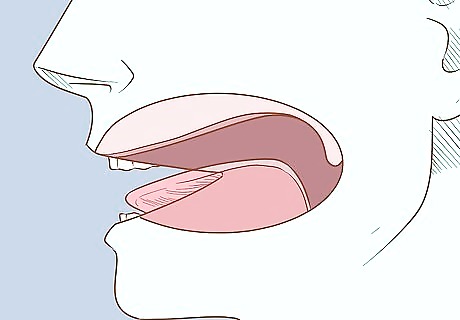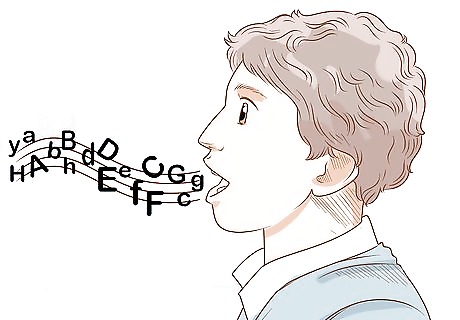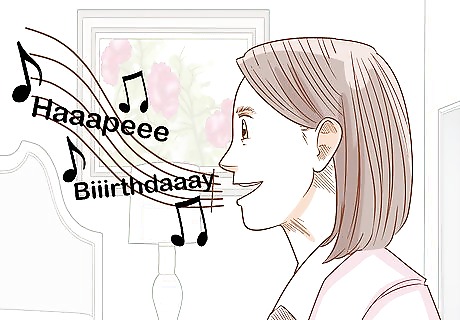
views
Practicing Proper Physical Techniques

Warm up with tongue trills to release tension and improve your tone. You can trill your tongue by holding your mouth open and placing your tongue either on the roof of your mouth or allowing it to rest with the tip touching the back of your bottom teeth. Take a deep breath and vibrate your tongue. It should sound similar to a cat purring. When the tongue is full of tension and in the wrong position, it can block the tone and cause the sound to be swallowed—making you sound throaty. A relaxed tongue will allow the tone to flow freely and sound more clear. In general, it is helpful to release the tension in your entire body before singing.

Control your breath flow by singing long tones. After doing lip trills, sing a note softly, then slowly increase the volume. Practice getting softer, louder, then softer again. This exercise can help you stay on pitch while also strengthening your breath control.

Keep your chin pointed downward while singing. Point your chin about 1 inch (2.5 cm) in toward your chest and down toward the ground. Keep your chin firmly in place as you sing the notes of an Ah scale. It may feel more natural to lift your chin upwards when you are projecting your voice. Try to avoid this—it may work temporarily, but can cause vocal problems in the long run. Keep it in place to gain more power and control and eliminate strain on your vocal cords. Practice in front of the mirror to make sure you have the correct position.

Keep your soft palate high and your tongue forward to get the right tone. A lowered soft palate creates a nasally sound when speaking or singing, which affects the clarity of your words. You need to create space at the back of your mouth by raising your soft palate in order to produce a clear, rich tone. To find your soft palate, run your tongue across the roof of your mouth. The hard part is called your hard palate and the fleshy bit towards the back of your mouth is called your soft palate. To raise your soft palate, yawn or laugh. That feeling of space in the back of your mouth is your soft palate being raised. You should have this feeling every time you sing. Take a look at this YouTube video of someone singing inside an MRI machine to see what happens inside the body when you're singing: https://www.youtube.com/watch?v=J3TwTb-T044&t=157s.

Check for a vibration in your face to confirm you are singing correctly. You should feel the vibration in your head, face, and lips. If you feel this vibration while you are singing, it means that you are resonating effectively. Proper resonance and vibration allows you to produce a clear tone with a strong projection without using excessive force. If you don’t feel the vibration in your face while you are singing, keep practicing your tongue trills and make sure your chin is pointed in and down while you are singing. For additional help, try slowly shaking your head from side to side while humming.
Controlling Your Vocals

Control your breathing. Breathe in and out using your diaphragm (your stomach). When you breathe in, your stomach should expand. When you breathe out, it should go back. Make sure that there is no movement in your chest. Singing from your chest or throat is shallow and unsupported, whereas singing from your diaphragm allows you to use your 'powerhouse' to support the notes you are singing and keep you in tune. Note that you are not actually breathing from your diaphragm, since your diaphragm doesn’t hold air. This term is more of a reference to the way your diaphragm moves and responds to proper, controlled breathing. Breathing while singing is different from breathing while talking or resting, which you do without much thought or effort. When singing, you have to pay attention to your breath control and ensure you have plenty of air.

Articulate your words clearly so listeners can understand the lyrics. Articulating your words clearly, distinctly, and fluently is extremely important while singing. Even if you have an amazing voice, your listeners can’t connect with you or your song if they can’t understand the words you are saying. Practice a few tongue twisters to help you improve your enunciation: She says she shall sew a sheet. Lesser leather never weathered lesser wetter weather. She stood on the balcony, inexplicably mimicking him hiccupping, and amicably welcoming him home.

Be very deliberate when enunciating your vowels. Paying special attention to the vowels (A, E, I, O, U) can make a tremendous difference in the clarity of your singing. It helps to clearly differentiate the shape of your mouth for each vowel. It may feel silly or exaggerated, but this is one of the best ways to ensure the vowels are prominent and your voice is clear. If you don’t focus on your vowels, you may have the tendency to sound like you are mumbling. For instance, “Happy birthday” should sound like “Haaappeee biiirthdaaay” To sing a word that begins with a vowel, imagine adding a tiny bit of an "h" before the vowel and think about arriving at the note from a higher note. This technique, called easy onset, helps to prevent a harsh sound (glottal stop) as well as scooping up to the note.

Practice scales to see a noticeable improvement in your tone and clarity. Scales, as boring as they may be, are the best way of getting a clearer, brighter tone. Start with singing the classic solfège scale: do, re, mi, fa, sol, la, ti, do. You can also simply sing, “Ahh” as you sing through the scale. As you work on the scales, practice long notes and short notes, and high tones and low tones. Exaggerate your sounds while practicing your scales. Your mouth should be open wide (but don't over-exaggerate this, as it can lead to tightness in your jaw) and your voice very loud. Try words like “Yeah” and “No.” Don’t go higher than is comfortable so you don’t put too much strain on your vocal cords. Search “practice scales” on YouTube to get access to a variety of videos that will guide you. Set aside 5-10 minutes each day to devote to practicing scales.

Replace the words in a well-known song to help you enunciate clearly. Think of a song that you know and can sing well. Now replace every word in the song with one of the following words: Mom, Nay, No, Go, Gug. This sort of easy practice can help you enunciate clearly while hitting every note. Experiment with the different words to find which one is easiest for you. Once you find it, try mastering a couple different songs using your chosen word. Taylor Swift Taylor Swift, Singer & Businesswoman Embrace your passion for singing. "I have been singing randomly, obsessively, obnoxiously for as long as I can remember."



















Comments
0 comment